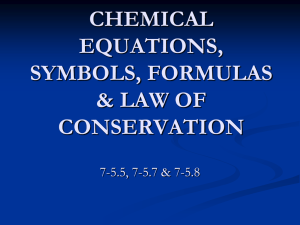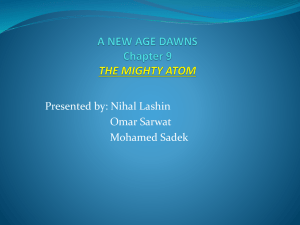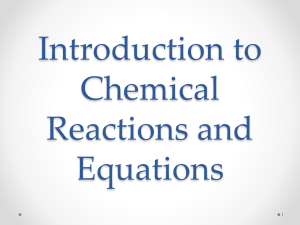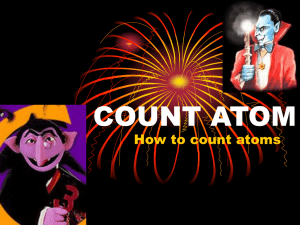Balancing equations hints
advertisement
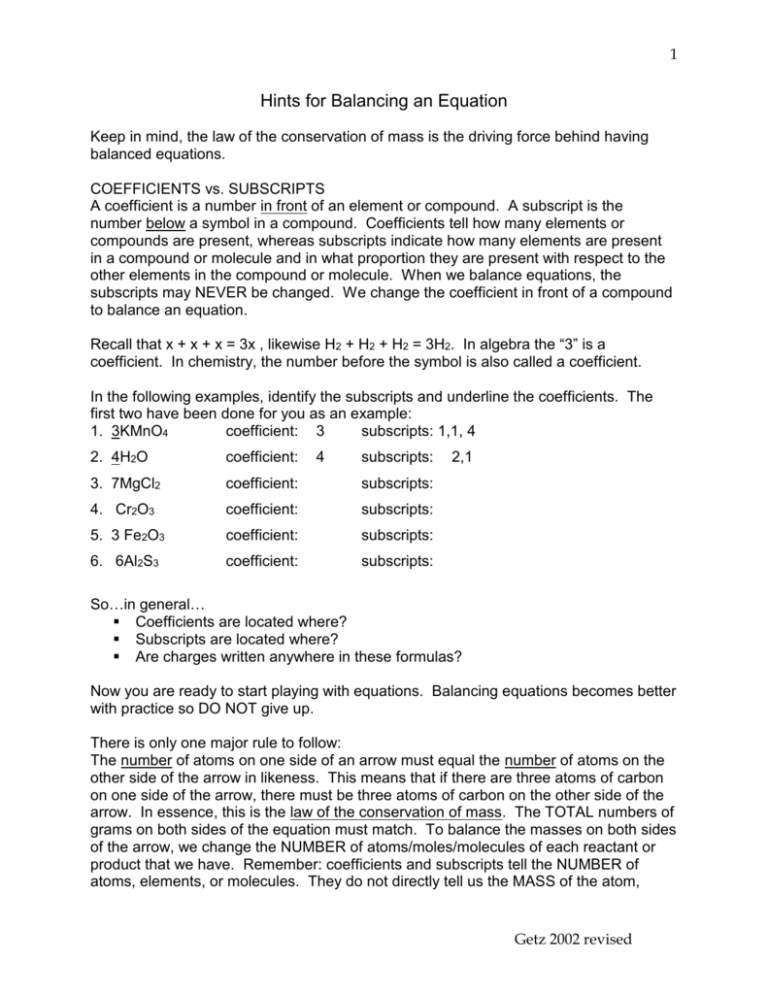
1 Hints for Balancing an Equation Keep in mind, the law of the conservation of mass is the driving force behind having balanced equations. COEFFICIENTS vs. SUBSCRIPTS A coefficient is a number in front of an element or compound. A subscript is the number below a symbol in a compound. Coefficients tell how many elements or compounds are present, whereas subscripts indicate how many elements are present in a compound or molecule and in what proportion they are present with respect to the other elements in the compound or molecule. When we balance equations, the subscripts may NEVER be changed. We change the coefficient in front of a compound to balance an equation. Recall that x + x + x = 3x , likewise H2 + H2 + H2 = 3H2. In algebra the “3” is a coefficient. In chemistry, the number before the symbol is also called a coefficient. In the following examples, identify the subscripts and underline the coefficients. The first two have been done for you as an example: 1. 3KMnO4 coefficient: 3 subscripts: 1,1, 4 2. 4H2O coefficient: 4 subscripts: 3. 7MgCl2 coefficient: subscripts: 4. Cr2O3 coefficient: subscripts: 5. 3 Fe2O3 coefficient: subscripts: 6. 6Al2S3 coefficient: subscripts: 2,1 So…in general… Coefficients are located where? Subscripts are located where? Are charges written anywhere in these formulas? Now you are ready to start playing with equations. Balancing equations becomes better with practice so DO NOT give up. There is only one major rule to follow: The number of atoms on one side of an arrow must equal the number of atoms on the other side of the arrow in likeness. This means that if there are three atoms of carbon on one side of the arrow, there must be three atoms of carbon on the other side of the arrow. In essence, this is the law of the conservation of mass. The TOTAL numbers of grams on both sides of the equation must match. To balance the masses on both sides of the arrow, we change the NUMBER of atoms/moles/molecules of each reactant or product that we have. Remember: coefficients and subscripts tell the NUMBER of atoms, elements, or molecules. They do not directly tell us the MASS of the atom, Getz 2002 revised 2 element, or molecule. Knowing the difference between numbers (1, 2, 3, etc.) of things and amount of mass (16 g/mol) is vital to understanding how balanced equations work. The general form of an equation is: reactants yields products the arrow, , is read as the word, yields. It means that the stuff on the left side of the arrow reacts and becomes the stuff on the right side of the arrow. Now to balance equations... Look at the following equation: iron + sulfur iron (II) sulfide becomes Fe + S FeS look at the left and the right sides of the equation: left side right side 1 atom of Fe 1 atom of Fe 1 atom of S 1 atom of S It is balanced. For the next equation, potassium + chlorine potassium chloride in symbols: K + Cl2 KCl look at the left and the right sides of the equation: left side right side 1 atom of potassium 1 atom of potassium 2 atoms of chlorine 1 atom of chlorine Wait! It is not balanced because there are not the same numbers of each type of element on both sides of the arrow. To balance it we must change the coefficients. WE CANNOT CHANGE THE SUBSCRIPTS. We can add more molecules, but we cannot change the composition of the molecules. The ratio of the elements in a compound is CONSTANT and cannot be changed. So to begin, we will make it so there are 2 atoms of chlorine on the right side. 3 K + Cl2 KCl + KCl Which becomes: K + Cl2 2KCl The 2 is placed before the KCl because we cannot split up the KCl. Saying K2Cl would be incorrect. In chemistry language, K2Cl is nonsensical. We can’t just add a Cl because on the right side of the equation, the Cl comes packaged with the K, as KCl. Remember 2 KCl = KCl + KCl Our table becomes: left side 1 atom of potassium 2 atoms of chlorine right side 2 atoms of potassium 2 atoms of chlorine Are we done? No. We now have the potassium atoms out of balance. To change this, we place a 2 as the coefficient for the potassium atom on the left side of the arrow. Recall that 2K = K + K 2K + Cl2 2KCl Now if we check if we are balanced, we find: left side 2 atoms of potassium 2 atoms of chlorine right side 2 atoms of potassium 2 atoms of chlorine Indeed, we are balanced. The next step involves you balancing equations with much repetitiveness until you can do this in your sleep. NOTE: You will come across diatomic molecules as you write equations. “Diatomic molecules” means that the atoms do not exist by themselves, but instead they only exist in nature as pairs. The 7 diatomic molecules are: N2, O2, F2, Cl2, Br2, I2, and H2. A short-cut method to remembering them is that they make a 7 on the periodic table beginning with the 7th element and going down the halogens, and then include hydrogen. ONLY make an element diatomic when it is NOT in a compound. Getz 2002 revised 4 Practice balancing the following equations: (please forgive typos) Na + Cl2 NaCl Mg + O2 MgO Al2O3 + Mg MgO + Al Al2(SO4)3 + BaCl2 AlCl3 + BaSO4 hint: treat the SO4 as if it is a regular element. Do not bother counting the sulfur and oxygen separately since they occur in similar form on both sides of the equation. O2 Fe2(SO4)3 + Al(ClO3)3 Co3(PO4)2 + Ca(C2H3O2)2 ZnSO4 + Fe3(PO4)2 H2 + H2O Al2(SO4)3 + Fe(ClO3)3 Co(C2H3O2)2 + Ca3(PO4)2 Zn3(PO4)2 FeSO4 +


